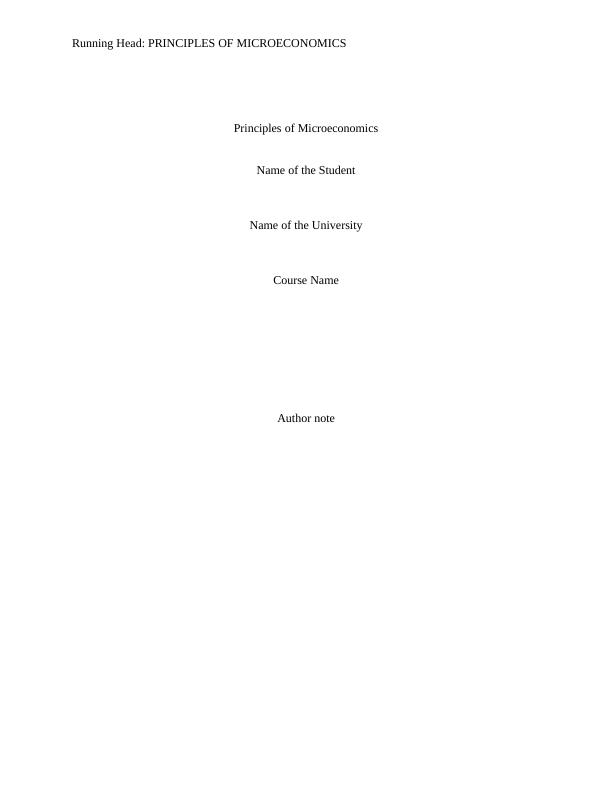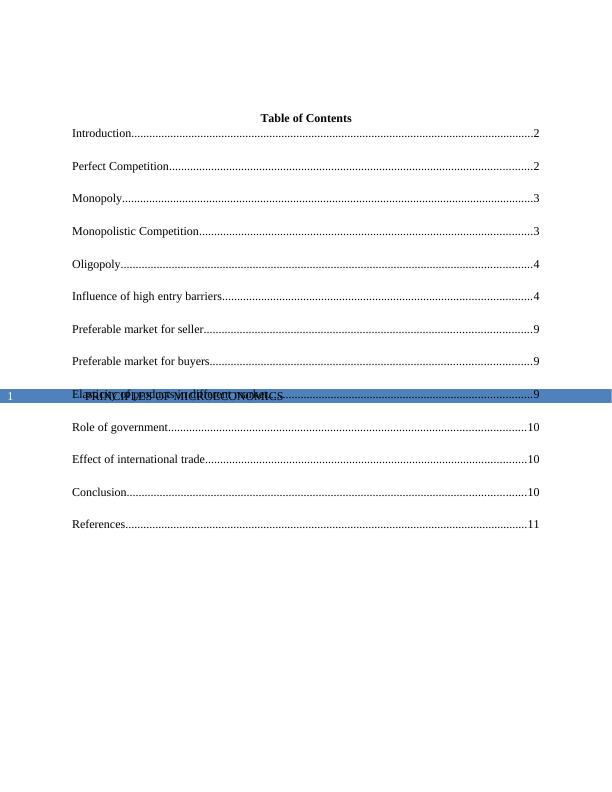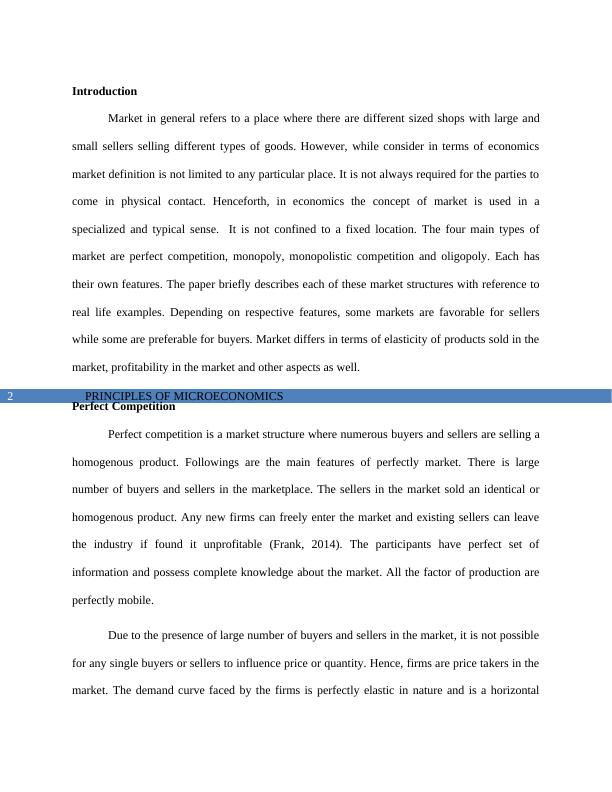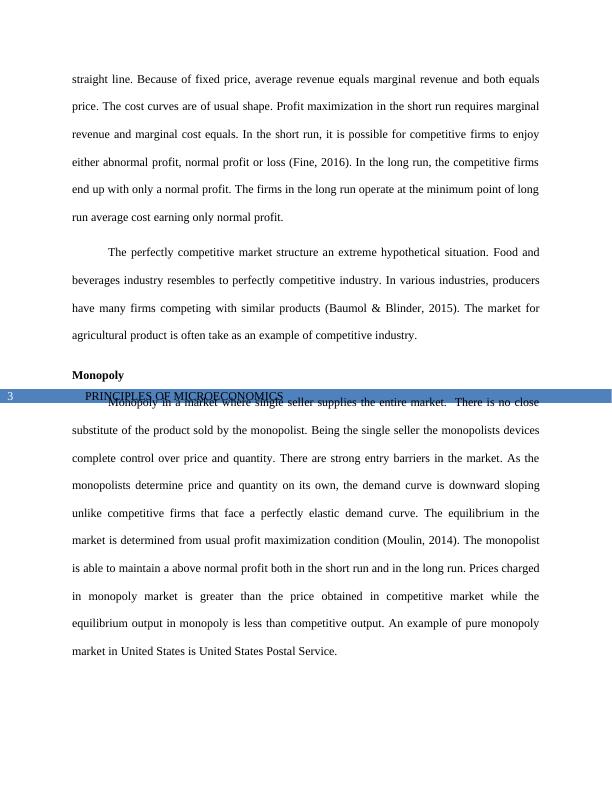Principles of Microeconomics Assignment
13 Pages2832 Words54 Views
Added on 2020-05-28
Principles of Microeconomics Assignment
Added on 2020-05-28
ShareRelated Documents
Running Head: PRINCIPLES OF MICROECONOMICS Principles of MicroeconomicsName of the StudentName of the UniversityCourse NameAuthor note

PRINCIPLES OF MICROECONOMICS 1Table of ContentsIntroduction......................................................................................................................................2Perfect Competition.........................................................................................................................2Monopoly.........................................................................................................................................3Monopolistic Competition...............................................................................................................3Oligopoly.........................................................................................................................................4Influence of high entry barriers.......................................................................................................4Preferable market for seller.............................................................................................................9Preferable market for buyers...........................................................................................................9Elasticity of products in different market........................................................................................9Role of government.......................................................................................................................10Effect of international trade...........................................................................................................10Conclusion.....................................................................................................................................10References......................................................................................................................................11

PRINCIPLES OF MICROECONOMICS 2Introduction Market in general refers to a place where there are different sized shops with large andsmall sellers selling different types of goods. However, while consider in terms of economicsmarket definition is not limited to any particular place. It is not always required for the parties tocome in physical contact. Henceforth, in economics the concept of market is used in aspecialized and typical sense. It is not confined to a fixed location. The four main types ofmarket are perfect competition, monopoly, monopolistic competition and oligopoly. Each hastheir own features. The paper briefly describes each of these market structures with reference toreal life examples. Depending on respective features, some markets are favorable for sellerswhile some are preferable for buyers. Market differs in terms of elasticity of products sold in themarket, profitability in the market and other aspects as well. Perfect Competition Perfect competition is a market structure where numerous buyers and sellers are selling ahomogenous product. Followings are the main features of perfectly market. There is largenumber of buyers and sellers in the marketplace. The sellers in the market sold an identical orhomogenous product. Any new firms can freely enter the market and existing sellers can leavethe industry if found it unprofitable (Frank, 2014). The participants have perfect set ofinformation and possess complete knowledge about the market. All the factor of production areperfectly mobile.Due to the presence of large number of buyers and sellers in the market, it is not possiblefor any single buyers or sellers to influence price or quantity. Hence, firms are price takers in themarket. The demand curve faced by the firms is perfectly elastic in nature and is a horizontal

PRINCIPLES OF MICROECONOMICS 3straight line. Because of fixed price, average revenue equals marginal revenue and both equalsprice. The cost curves are of usual shape. Profit maximization in the short run requires marginalrevenue and marginal cost equals. In the short run, it is possible for competitive firms to enjoyeither abnormal profit, normal profit or loss (Fine, 2016). In the long run, the competitive firmsend up with only a normal profit. The firms in the long run operate at the minimum point of longrun average cost earning only normal profit.The perfectly competitive market structure an extreme hypothetical situation. Food andbeverages industry resembles to perfectly competitive industry. In various industries, producershave many firms competing with similar products (Baumol & Blinder, 2015). The market foragricultural product is often take as an example of competitive industry. MonopolyMonopoly in a market where single seller supplies the entire market. There is no closesubstitute of the product sold by the monopolist. Being the single seller the monopolists devicescomplete control over price and quantity. There are strong entry barriers in the market. As themonopolists determine price and quantity on its own, the demand curve is downward slopingunlike competitive firms that face a perfectly elastic demand curve. The equilibrium in themarket is determined from usual profit maximization condition (Moulin, 2014). The monopolistis able to maintain a above normal profit both in the short run and in the long run. Prices chargedin monopoly market is greater than the price obtained in competitive market while theequilibrium output in monopoly is less than competitive output. An example of pure monopolymarket in United States is United States Postal Service.

End of preview
Want to access all the pages? Upload your documents or become a member.
Related Documents
Economics for Managerslg...
|21
|3971
|408
Competitive Market Profit Assignment Reportlg...
|10
|2570
|16
Monopolistic Competition and Oligopoly Marketslg...
|10
|849
|321
Characteristics of Perfect Competition and Monopoly Marketlg...
|19
|4154
|468
Types of Market Structure: Perfect Competition, Monopoly, Oligopoly, Monopolistic Competitionlg...
|19
|4224
|23
Monopoly and Monopolistic Competition in Australian Marketlg...
|11
|3186
|150
